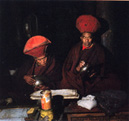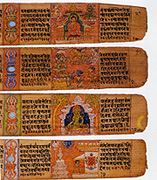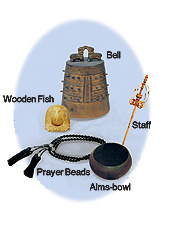| |
◎
An
Introduction to the Sutras and Dharma Instruments
│1│2│3│4│ |
|
(2)The
Origin of the Palm-Leaf Buddhist Manuscripts
The earliest Buddhist sutras were written on leaves of the talipot palm
tree and are known as the palm-leaf manuscripts. The talipot or fan palm
trees are tropical plants.
Talipot palm is found mainly in India, Sri Lanka, Burma and the southwest
region of China. In Taiwan, it is also called the “temple tree,” for the
locals believe that its flowers, which are commonly known as “egg flowers”
for their white petals and yellow centers, have the power to protect a
temple with their profuse fragrance and golden colors.
Why were the Buddhist sutras written on leaves of the talipot palm tree?
At that time in ancient India, paper had yet to be invented, so the leaves
were used as a medium for writing. Why weren't other types of leaves utilized?
It was because the leaves of the talipot palm were tougher, more pliable
and thus more suitable for writing.
 |
 |
 |
Palm-Leaf Buddhist Manuscripts/
Laos
|
Before the introduction of paper,
monks would recite the palm-leaf manuscripts. |
The Oldest Buddhist Manuscript in
Nepal |
(3 )The Process of Making
the Palm-Leaf Manuscripts
After the leaves were
cut from the palms, they were blanched (boiled in a cauldron), dried and
polished to a gloss on both sides. The prepared leaves were then trimmed
and pierced through the middle, with the text inscribed on the leaves
with a stylus and colored with ink. Finally, the finished strips were
bounded and secured with cord or twine.
Even after the introduction of paper as a medium for recording Buddhist
sutras, the sheets of paper were still being bounded in the same way as
the palm-leaf manuscripts. Besides paper, other materials were also used,
such as sheets of copper and birch bark. They are still called “palm-leave
manuscripts.”
B.
Most Commonly Used Dharma Instruments in Buddhism

|
What are Dharma
instruments? They are not only implements, tools or utensils of Buddhist
functions used in prayers, offerings and various services, but also instruments
used by practitioners in their daily practices.
In a temple, there are Dharma
instruments, such as the bell, the drum, the big bell-bowl and the wooden
fish. However, they are not intended for casual striking because they
are the eyes and ears of celestial guardians and heavenly kings as well
as signals for the masses to follow. Their sounds can only be heard during
Dharma services or morning and evening chanting. Therefore, we must remember
not to touch any of the Dharma instruments on display at a temple.
There are many kinds of Dharma instruments according to their size,
use and shape. Generally speaking, we can divide them into the following
three categories:
1. Dharma instruments used in making offerings to the Buddhas and Bodhisattvas,
including incense burner,
flower vase, and lamp.
2. Dharma instruments used in Buddhist chanting and recitation, including
the big bell-bowl, the wooden fish,
and the bell.
3. Instruments used by the monastics in their daily practices, including
prayer beads, staff, and alms-bowl.
|
|











